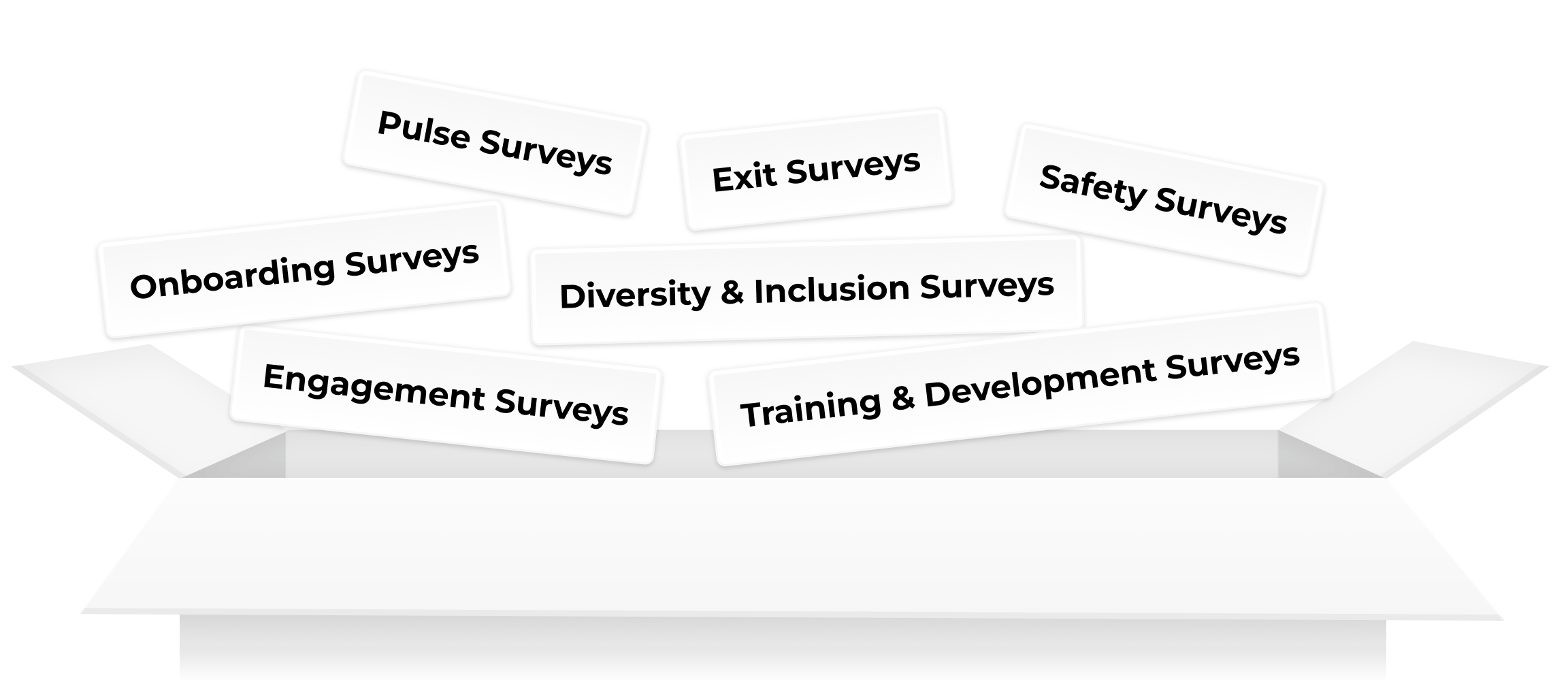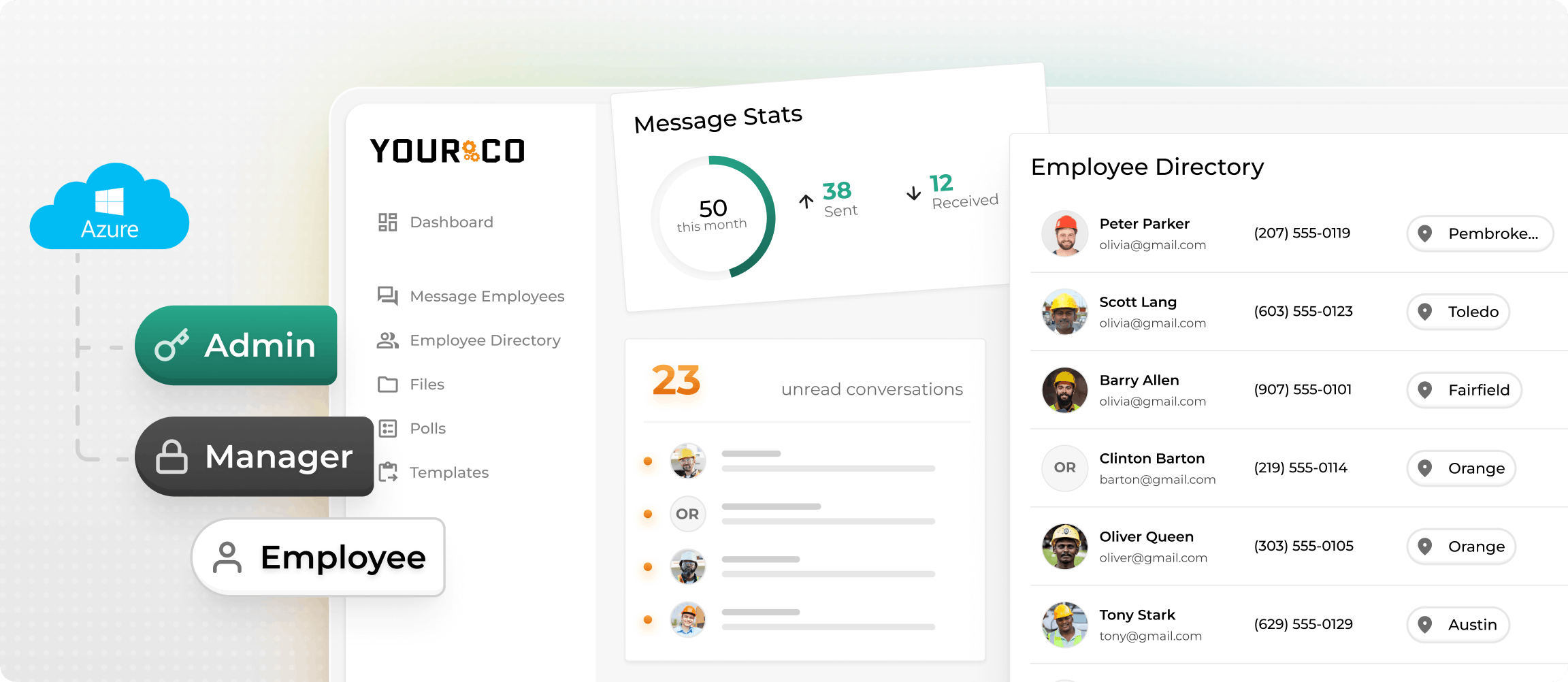Understanding Feedback From Your Frontline Workforce: Plus Examples For Employee Surveys


Hearing feedback from your staff helps you understand their perspective and pinpoint areas that need attention. But how do you collect these insights when your employees work on factory floors, construction sites, or other non-desk environments? Traditional communication methods aren't cutting it for your frontline employees. That's where customized surveys step in, acting as a bridge over the communication gap.
Why It’s Important to Survey Your Frontline Workforce
Frontline employees aren't just numbers on a payroll. They're the individuals keeping your business moving forward. They simply don’t have the luxury of a traditional office setup.
Despite being critical to nearly every industry, from construction, manufacturing, and agriculture to healthcare, retail, and transportation, these workers often face unique hurdles. They operate in dynamic environments far removed from the typical desk and computer scene. That means many don't have corporate email addresses or access to company intranets, making conventional communication channels ineffective.
Relying on word-of-mouth or bulletin boards can turn vital messages into a game of "telephone," where the original intent gets lost in transmission. Ignoring these challenges doesn't just affect morale, but can also impact safety, productivity, and ultimately, your bottom line.
In fact, communication barriers drive up costs significantly, with productivity losses from miscommunication exceeding $26,000 per employee annually. When frontline workers lack clear channels to share feedback and receive consistent information, companies risk not only these financial losses but also the 51% spike in employee stress and 41% drop in productivity that plague workplaces with poor communication.
Bridge Communication Gaps with Customized Surveys
Standard surveys often miss the mark with non-desk workers. By tailoring survey questions to their specific roles and environments, you make the survey relevant and engaging. It's about meeting them where they are, both figuratively and literally.
When employees see that their opinions genuinely matter, engagement levels rise. A study by Talkfreely highlights how effective two-way communication fosters a sense of inclusion.
Frontline workers are your eyes and ears on the ground. Surveys can uncover hidden safety concerns, allowing you to address them before they escalate. Giving employees a voice leads to higher job satisfaction, which can reduce turnover and improve productivity.
By integrating customized surveys into your communication strategy, you collect data and empower your workforce in the process.
Choose the Ideal Survey Timing and Type
Choosing the right survey type ensures that the feedback you collect is relevant and leads to meaningful improvements. Maintaining a consistent survey schedule helps ensure that feedback remains timely and actionable.
- Quarterly: Schedule engagement surveys every three months to measure overall job satisfaction, motivation, and commitment to the company’s mission.
- Monthly/Biweekly: Use short pulse surveys to check in on morale and identify emerging trends over time.
- First 30–90 Days: Conduct onboarding surveys to gather insights from new employees about their initial experiences and areas for improvement.
- Final Week of Employment: Send exit surveys to understand why employees leave and uncover opportunities to reduce turnover.
- Annually: Run diversity and inclusion surveys to assess employees’ sense of belonging and the inclusivity of your workplace culture.
- Event-Driven/Regular Intervals: Distribute safety surveys to identify potential hazards and evaluate how employees perceive workplace safety measures.
- Post-Training: Conduct training and development surveys to determine if employees feel they have sufficient opportunities to learn and grow within the company.
To streamline your survey creation process, consider using employee survey templates that are pre-designed for common workplace scenarios.
Ask Questions That Resonate with Your Team
Crafting a survey that resonates with non-desk employees isn't just about the questions you ask. It's about how you ask them. Let's break down the essential components using four types of feedback.
1. Workplace Satisfaction
Happy employees are productive employees. Gauge their satisfaction with the work environment, tools, and relationships.
Sample questions include:
- "On a scale of 1-5, how satisfied are you with your current work environment?"
- "Do you have the necessary tools to perform your job effectively?"
2. Safety Feedback
Your frontline workers are best positioned to identify safety issues. Assess their views on current safety measures and their comfort level in reporting concerns.
Sample questions include:
- "Do you feel our safety procedures are adequate?"
- "Are you comfortable reporting safety concerns?"
3. Engagement and Morale
Understanding what motivates your employees can help improve morale. Explore their sense of purpose and recognition.
Sample questions include:
- "Do you feel your work contributes to our company's goals?"
- "How often do you receive recognition for your work?"
4. Training and Development Needs
Investing in your employees' growth pays dividends. Identify skill gaps and preferred training methods.
Sample questions include:
- "What skills would you like to develop further?"
- "How do you prefer to receive additional training?"
By focusing on these components, you're not just collecting feedback. You're showing your employees that you value their input and are committed to their well-being.
Design Surveys That Drive Real Engagement
Successfully engaging your frontline workforce through surveys requires more than just good questions. Ensuring accessibility will make sure your surveys hit the mark.
- Keep it short and simple. Your employees are busy. Respect their time by keeping surveys concise: aim for 5-10 minutes to complete.
- Use clear, straightforward language to ensure everyone understands what's being asked.
- Use channels they're already comfortable with. Since non-desk employees are often on the move, make surveys available on mobile devices as well as desktop computers.
- Provide surveys in multiple formats, especially if language barriers exist. For employees who need additional support, consider offering in-person assistance or follow-up conversations.
- Choose the right time of day. Distribute surveys during times when employees are more likely to respond, perhaps during breaks or at shift changes.
Most importantly, don't let the data collect dust. Analyze the feedback for actionable insights and share your findings with the team. Most importantly, implement changes where needed to show your employees that their input matters.
Turn Survey Data into Actionable Insights
Analyzing survey results is like putting together a puzzle. You can't get the full picture by merely looking at a few pieces. Each piece, or in this case, each comment, plays a part. To really understand results, you'll need to sort the responses into themes or categories like "communication," "safety," or "career development."
Let's say you've got a bunch of responses to a text message survey you sent out recently. Some folks are pleased with the teamwork at your company, while others might be frustrated with equipment issues. Don't just count these comments. Go further and try to understand why your employees feel this way. Is the team spirit due to regular team-building activities? Are the tools old because the budget hasn't allowed for new ones?
Remember not to jump to conclusions based on a single comment. A single negative or positive comment isn't indicative of a widespread issue or success. Repeating sentiments help you spot patterns and trends that matter.
Identify Positive Employee Feedback
Positive feedback examples often reflect satisfaction with management, safe working conditions, camaraderie with co-workers, or personal development opportunities. When employees are happy with their work, it shines through in their responses.
Here are a few examples how positive feedback looks like:
- "I appreciate the safety measures put in place. They make it easy to do my job well."
- "The management team listens to our concerns."
- "I enjoy the strong sense of teamwork and cooperation in my jobs."
- "I am grateful for all of the training provided to us."
Learn from Constructive Criticism
Negative survey comments, on the other hand, shine a light on areas for improvement. Constructive criticism drives progress, so treat these comments as opportunities for growth. Some constructive negative feedback examples could include:
- "Communication from management is rare and unclear."
- "Our equipment is old, and frequently breaks down."
- "There's limited opportunity for career growth."
- "Workplace safety procedures could be more thorough."
Don't view these comments as personal attacks. Instead, see them as stepping stones towards a better work environment.
Communicate to Build Trust and Transparency
The aim of surveys is to create an open dialogue with your employees, encourage their active participation in making improvements, and remind them that their opinions are valued.
Communicate Before and During the Survey
- Be transparent about why you're conducting the survey and how you'll use the results. This builds trust and encourages honest feedback.
- Offer incentives to encourage participation. Sometimes a small token of appreciation can boost participation rates. Consider offering modest rewards like gift cards or extra break time.
- Ensure anonymity and confidentiality. Employees are more likely to provide honest feedback if they feel their responses are anonymous. Assure them that their answers will remain confidential and will be used solely for improving the workplace environment.
Share the Survey Results
Discussing survey results with your team can be tricky. The key is transparency and openness. Find fun ways to communicate survey results, like hosting a team BBQ or potluck where results are unveiled. You can even make it interactive by organizing a trivia game where employees guess statistics from the survey.
For workplaces that don't gather often, consider incorporating the survey results into regular communications or meetings. You could print out colorful, easy-to-understand graphs and post them on bulletin boards or other common areas. For teams on-the-go, you could use text messaging to send bite-sized survey insights directly to your employees' mobile phones. This method keeps everyone informed, no matter where they are.
Supplement Surveys with Strategic Conversations
While surveys provide valuable quantitative insights, they shouldn't be the only tool in your employee engagement strategy. To gain a deeper understanding of workplace concerns, employers should initiate strategic conversations with employees. These discussions can provide richer, more nuanced feedback than surveys alone.
Here are some effective ways to foster in-depth conversations:
- Small Group Discussions: Organize focus groups where employees can share their thoughts in a relaxed, open environment.
- One-on-One Check-Ins: Regularly scheduled meetings between managers and employees allow for personalized feedback.
- Town Hall Meetings: Encourage open dialogue by allowing employees to ask leadership questions in real time.
- Anonymous Feedback Sessions: Provide a safe space for employees to voice concerns without fear of repercussions.
- Cross-Department Collaboration: Facilitate discussions between different teams to break down silos and encourage new ideas.
By supplementing surveys with strategic conversations, companies can foster a culture of trust, transparency, and continuous improvement. This holistic approach ensures that employees feel truly heard, valued, and engaged in their workplace experience.
Reach Every Employee with SMS Communication
An engaged workforce starts with clear communication. When your non-desk employees can share feedback and stay informed, they feel more connected to their work and your organization thrives. The challenge lies in reaching teams scattered across shifts, sites, and job roles—especially when traditional communication tools fall short.
Yourco makes it simple. Send surveys, announcements, and updates straight to employees' phones via text. No app downloads, no internet required, and it works on any device. Text messages get read 98% of the time compared to just 20% for email, so your messages get seen and acted on faster.
You can have real conversations with your team through two-way messaging, communicate in their preferred language with automatic translation, gather feedback through quick polls, and share important documents securely. Everything syncs with your payroll and HR systems to keep employee information current without extra work.
When you make it easy for employees to stay informed and share their voice, they feel more invested in their work. Yourco helps you build that connection without adding complexity to your day. Contact us to set up a demo, or try it for free today.
Frequently Asked Questions
What is the best way to distribute employee surveys to frontline workers?
SMS-based distribution works best for frontline employees because it reaches them directly on their mobile phones without requiring app downloads or email access. Text messages have a 98% read rate compared to only 20% for emails, making them far more effective for collecting feedback from frontline teams. You can send survey links via text that employees can complete on any device during breaks or between shifts.
How often should I survey my non-desk employees?
Survey frequency depends on your goals. Pulse surveys work well every two weeks or monthly for quick check-ins on morale and immediate concerns. Quarterly engagement surveys provide deeper insights into job satisfaction and commitment. Safety surveys should be conducted regularly at set intervals or immediately following incidents. The key is maintaining consistency without overwhelming your team with too many requests.
What's the ideal length for an employee survey?
Keep surveys short and focused, especially for non-desk workers who have limited time. Aim for surveys that take 5-10 minutes to complete, typically 8-12 questions maximum. Shorter surveys see significantly higher completion rates. If you need to gather extensive feedback, consider breaking it into multiple shorter surveys over time rather than one long questionnaire.
How can I encourage honest feedback from employees who fear retaliation?
Ensure complete anonymity and clearly communicate that responses cannot be traced back to individuals. Use a third-party platform or tool that doesn't collect identifying information. Explain how you'll use the data in aggregate form only. Most importantly, demonstrate that you act on feedback constructively without singling out individuals. Building this trust over time leads to more candid responses in future surveys.
What should I do if survey participation rates are low?
Low participation often signals timing issues, survey fatigue, or lack of trust that feedback leads to change. Try different distribution times that align with shift schedules. Communicate clearly why the survey matters and how previous feedback led to concrete improvements. Consider offering small incentives like gift cards or extra break time. Make surveys mobile-friendly and keep them brief. Most importantly, close the feedback loop by sharing what you learned and what actions you're taking.





